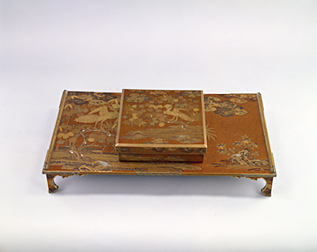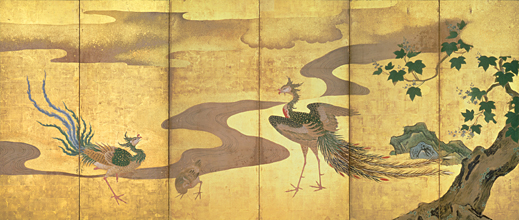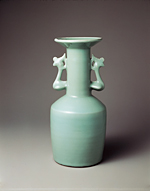 |
Focus features two in-depth reviews each month of fine art, architecture and design exhibitions and events at art museums, galleries and alternative spaces around Japan. The contributors are non-Japanese art critics living in Japan. |
|
|
 |
 |
 |
Symbols of Immortality: The Phoenix and the Lion
Lucy Birmingham |
 |
 |
|
 |
| "Low Desk and Writing Box with Design of Paulownia, Bamboo, and Phoenix"; maki-e, Momoyama Period, late 16th to early 17th century, Important Cultural Property. Courtesy of Suntory Museum of Art |
|
Nonomura Ninsei, "Spherical Incense Burner with Chinese Lion-dog Knobbed Cover"; Edo Period, latter half of 17th century. Courtesy of Suntory Museum of Art |
The lion and the mythical phoenix are auspicious symbols that have been embedded in Japanese culture for centuries. But the lion is not indigenous to Japan, and the phoenix is an otherworldly creature. So how on earth did they come to Japan? Ancient writings reveal that it was through China and Korea. Their transition from those foreign lands, and their artistic transformation in Japanese religion, rituals, performing arts, and decorative motifs, is the intriguing theme of "Symbols of Immortality: The Phoenix and the Lion," at the Suntory Museum of Art in Tokyo until July 24. The show is part two of a four-part exhibition series titled "Art revisited, beauty revealed" that celebrates the museum's 50th anniversary.
Asiatic lions -- smaller than African lions -- never roamed across China but were indigenous to Persia and the Indian subcontinent. Their prized pelts were traded along the Silk Road, eventually reaching China during the Han Dynasty 2,200 years ago. Captured live, they were offered to the Han imperial court as exotic gifts.
 |
Odano Naotake, "Lion," Edo Period,
18th century. Private collection |
The image of the lion was probably introduced to Japan from China via Korea in the 7th or 8th century, along with Buddhism. Lion-like statues made of wood and stone were placed as pairs at the entrances of shrines and temples to ward off evil. During the Heian Period (794-1185) the lion in Japan became a combination of the Korean Koma-inu (Korean dog) displayed with a closed mouth and the Chinese Kara-shishi (Chinese lion) shown with an open mouth. The open mouth relates to "Ah," the first sound in the Japanese alphabet, and the closed mouth to "Un," the last sound. The two sounds symbolize the stages of life -- beginning and end, birth and death, and all possible outcomes. (The spiritual Sanskrit sounds "AHAM" and "AUM" are quite similar.)
In the exhibition, my favorite pair is the wooden "Komainu Figures (A and Un Forms)" from Kozanji Temple, dated 1225 (Kamakura Period). More cute than ferocious, these two seem to have lost their master -- a 13th-century Hachiko perhaps. The lion in Japan was evolving from a symbol of aggression and power to playful entertainer.
Probably the best portrayal of the lion's "new" persona was the shishi-mai or lion dance, still performed today. In the exhibition, an illustrated handscroll from the 15th century shows comical shishi-mai performers stared at by a curious monkey.
During the peaceful years of the Edo Period (1603-1868) the playful lion was matched with the peony in the Noh and Kabuki play titled Shakkyo (Lion Bridge). In the 1751 screen painting "Shakkyo at Mt. Tendai" by Sakaki Hyakusen, a clown-like, corpulent lion is adorned with a bright red peony atop its head. This lion-peony pairing became a symbol used in auspicious ceremonies and festivals. In kimono, peonies and the wavy lines of a lion's mane became an auspicious design element.
The lion dance Kagami-jishi, a popular Kabuki classic that premiered in 1893, revisits the creature's strength and bravery as guardian of heaven. At the peak of the dance, the actor whips his long white mane-like wig with choreographed, dramatic frenzy. A small wooden depiction of the Kagami-jishi character is included in the Suntory show.
It was in the 18th century, through Dutch drawings, that images of and information about real lions first came to Japan. Painter Odano Naotake, inspired by the drawings, created the hanging scroll "Lion" (18th c.) -- a striking clash of reality and imagination (and a hairdresser's nightmare come true).
In the Meiji Era, when Japan opened its doors to the West, the Japanese finally had the chance to see real lions up close in zoos and circuses. For the first time, realistic depictions of lions existed side by side with the mythical Chinese beast. Takeuchi Seiho, one of the greats of the modern Nihonga (Japanese painting) movement, was fascinated with this majestic creature. His lion paintings, including "Large Lion" and sketches made during a tour of zoos in Antwerp, are part of the Suntory show.
 |
|
 |
| Kano Tan'yu, "Phoenixes by Paulownia Trees" (left and right screens); pair of six-fold screens, Edo Period, 17th century. Courtesy of Suntory Museum of Art |
The mythical Asian phoenix is very different from the legendary Egyptian and Greek phoenix which, with a lifespan of 500 to 1,000 years, is reborn from its own ashes. The immortal Chinese version is a bizarre but enchanting amalgam of animals, with a bird's beak, a snake's neck, a frontal body that resembles a giraffe, a rear like a deer and an arched back that references a tortoise. Its 12 feathers resemble those of a peacock with a plume in the five mystical colors of black, white, red, green and yellow.
In China, this revered creature was used as a symbol over 7,000 years ago on objects such as good-luck talismans. From about 2,000 years ago it came to represent power sent to the Empress from the heavens. It was believed a phoenix would descend from the heavens to do good deeds and return to its celestial abode to await a new era. Visions of the phoenix god were considered omens of great luck and peace.
The phoenix in Japan, known as ho-o, came from China, probably in the Asuka Period during the mid-6th to mid-7th centuries. As in China, it was identified with the imperial household, particularly the Empress, and often paired with the paulownia leaf and flower.
 |
| "Vase, with phoenix ears, celadon glaze"; Long-quan ware, S. Song Dynasty, 12th to 13th century, Important Cultural Property. Courtesy of the Gotoh Museum |
Japan's most famous phoenixes stand as a pair, each a meter high, on the roof of the Ho-o-do (Phoenix Hall) at Byodoin temple in the city of Uji, just south of Kyoto. (The hall is depicted on the Japanese 10 yen coin.) Originally built in 950, it became a UNESCO World Heritage site in 1994. The Suntory exhibition displays a reproduction of the original.
In the Nara Period (710-94) the phoenix became a popular, auspicious design motif on items ranging from textiles to chests. Throughout the 13th to 19th centuries, it was an important design element on lacquerware. Examples in the exhibition include the maki-e (gold-sprinkled lacquer) set "Low Desk and Writing Box with Design of Paulownia, Bamboo, and Phoenix" (late 16th-17th c.), designated an Important Cultural Property.
One of the most striking treasures in the show is a pair of six-panel golden screens by Kano Tan'yu (1602-74) titled "Phoenixes by Paulownia Trees." Two other versions of the same scene by different artists are also on display, providing a rich comparison.
The phoenix also plays a central role in the magnificent pair of six-panel screens by Ito Jakuchu (1716-1800) titled "Birds, Animals, Trees and Flowers." The unusually modern work, painted as a grid of squares, has an optical-illusionary quality. From a distance, the one-centimeter squares appear like tiles in a mural. But up close, one can see that each has been painted individually -- a fascinating but painstakingly meticulous process emblematic of this eccentric and popular artist.
The Suntory Museum of Art has much to celebrate since its opening in 1961 as the cultural arm of the whiskey distiller. Then-president Keizo Saji spearheaded the acquisition of what is now a 3,000-piece collection that includes one official National Treasure and 12 Important Cultural Properties among a priceless assemblage of Japanese ceramics, folding screens, kimonos, textiles, lacquerware and glassware. Originally located in Tokyo's Akasaka-mitsuke district, the museum moved in 2007 to the Midtown complex in Roppongi. Architect Kengo Kuma designed its new quarters with a mix of contemporary technology and traditional Japanese elements.
Amalgamating the old and the new has been a mainstay of Japanese art through the ages. The lion and phoenix are propitious symbols, but they also epitomize a remarkable capacity for artistic adaptation -- the means of immortality for Japanese art.
|
 |
 |
Lucy Birmingham
Based in Japan for almost 25 years, Lucy Birmingham has written for Newsweek, Bloomberg News, Architectural Digest, The Boston Globe, Artinfo.com, Artforum.com, and ARTnews, among other publications. As a photojournalist her work has appeared in The New York Times, Business Week, Forbes, Fortune, U.S. News and World Report, and A Day in the Life of Japan. She is also a scriptwriter and contributing editor at NHK, Japan's public broadcaster, and has published several books including Old Kyoto: A Guide to Traditional Shops, Restaurants, and Inns. |
|
 |
|